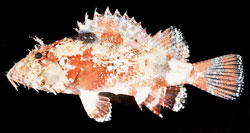Articles and reports from the Life Sciences and chemistry area deal with applied and basic research into modern biology, chemistry and human medicine.
Valuable information can be found on a range of life sciences fields including bacteriology, biochemistry, bionics, bioinformatics, biophysics, biotechnology, genetics, geobotany, human biology, marine biology, microbiology, molecular biology, cellular biology, zoology, bioinorganic chemistry, microchemistry and environmental chemistry.

An estimated 5,000 previously unknown ocean fish species and hundreds of thousands of other marine life forms are yet to be discovered, according to scientists engaged in a massive global scientific collaboration to identify and catalog life in the oceans.
The new marine fish species, being identified at an average rate of 160 per year (roughly three new species per week since year 2000), are being catalogued and mapped by the Census of Marine Life (CoML), an unprecedented cooperativ

Predisposition to many common diseases – among which cancer, cardiovascular conditions, diabetes, asthma, etc. – is said to be a multifactor phenomenon as it results from numerous genes as well as environmental factors. Identifying such predisposition genes is one of the major challenges in modern genetics and could contribute to establishing new preventive medicine patterns and developing new specific drugs.
However, the identification of predisposition genes appeared to be extremely diffic

Understanding cancer
Mayo Clinic researchers are the first to describe what goes wrong during the growth cycle of certain cells that can lead to inherited forms of breast cancer. Knowing the nature of this biochemical modification is a first step to designing drugs that can correct it to stop cancer.
The Mayo Clinic research finding appears in today’s issue of the journal Science. It is important because it solves an aspect of a mystery that cancer researchers worldwide have

Walruses are ’right-flippered’, according to research published this week in BMC Ecology. The first study of walrus feeding behaviour in the wild showed that the animals preferentially use their right flipper to remove sediment from buried food. This is the first time that any aquatic animal has been shown to prefer using one flipper to the other when foraging. Direct observations of the underwater behaviour of free-living marine mammals are rare, especially if the animals are dang

Scientists here have found that a protein in the retrovirus known as human T-cell lymphotropic virus type 1 (HTLV-1) can cause immune cells to divide and proliferate, helping the virus spread through the body.
The protein, known as p12, was formerly thought to be unimportant during infection, causing scientists to regard it as a nonessential “accessory gene.”
This new study, however, shows that the protein forces infected cells to produce interleukin 2 (IL-2), a substance that stimu

Johns Hopkins scientists have discovered that the eye’s vision-producing rods and cones cannot tell the difference between their respective light-detecting molecules. The findings appeared in a recent issue of Nature.
At the heart of the researchers’ side-by-side comparison is the quest to solve a fundamental mystery of vision: how rods and cones have such different sensitivities to light despite using very similar processes to detect it.
Rods function in near darkness,